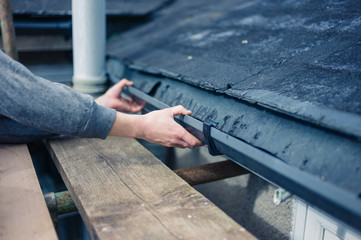When it comes to installing gutters, there are many things that you should keep in mind. Selecting the type of guttering that will best serve your needs is important. This will help ensure you can enjoy the benefits the guttering offers for years to come. Also, you will want to consider the cost of installing a new gutter. This will allow you to determine if the installation costs are worth the money you will spend.

Choosing the right downspouts for Gutter Installation Tampa can help you to direct water away from your home, foundation, or sewage system. Properly installed downspouts help minimize the risk of water damage to your roof, landscaping, and eaves. It can also boost the value of your property.
There are many downspout styles and materials available. Common downspouts are made from aluminum, vinyl, and stainless steel. These downspouts are easy to maintain and come in a variety of colors. The most common material for downspouts is aluminum. This is lightweight and can blend in with the siding of your house. It is also less likely to rust than other downspouts.
Another downspout style is the seamless downspout. It is a large piece of material with minimal joints. It takes longer to install but is cost-effective. Consider installing splash guards to keep water from splashing over your downspouts. They can also prevent your gutter system from overflowing and overloading.
Downspout extensions are an excellent way to optimize your gutter system. They allow you to control water flow in your gutters and prevent clogging. They can also help you eliminate flooding on your property. Downspouts are integral to a gutter system and must be installed correctly. When looking for downspout extensions for your home, ensure you get the best one for your needs. There are a few ways to do this.
Adding a splash block is one of the easiest ways to keep water from splashing over your gutters. This small aluminum gutter material can be moved during weather events to keep the gutters free of splattering water. However, these may not be as aesthetically pleasing as a downspout extension.
A downspout extension is a small pipe that connects your existing downspout to another. The pipe is typically made from either plastic or aluminum. It should be buried at least eight feet away from your home, and you should use waterproof screws to connect the two. This means that it is both cheap and easy to install.
A downspout is a crucial part of a gutter drainage system. These metal or plastic devices direct water away from the foundation of a home. They are generally 3 to 4 inches in diameter. However, some downspouts may be smaller. The cost of downspouts varies according to the material they are made of. They come in aluminum, steel, and copper. Depending on the size of your downspout, you can expect to pay between $10 and $200.
Galvanized steel downspouts are less likely to rust than aluminum downspouts. They are also more durable and less likely to dent. They are available in both round and rectangular shapes. They are sold in 10-foot lengths. Downspouts also have end caps, which seal off the ends of the gutters. This ensures that there is no spillage of water from the downspout. Each end cap is typically priced at $2 to $6.
If you’re looking for new gutters for your home, it’s important to consider your options before deciding on the right style and material. Your choices will depend on your budget, your climate and the amount of rain in your area. It’s also a good idea to talk to a pro to help you decide on the best design and materials for your project.
The gutter system protects your foundation by directing water away from your house. Downspouts are placed at the end of each roof line and channel water to the ground. Depending on the type of gutter, it may be necessary to have downspouts as well. If you live in an area with heavy rainfall, you’ll need a larger gutter to channel the water. A standard 5-inch K-style gutter can handle 1.2 gallons of water per linear foot. A six-inch gutter can hold 40 percent more water.